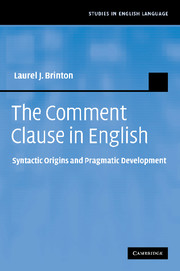Book contents
- Frontmatter
- Contents
- List of figures
- List of tables
- Acknowledgments
- List of abbreviations
- 1 Introduction: comment clauses, parentheticals, and pragmatic markers
- 2 Semantic and syntactic development of pragmatic markers
- 3 Processes of change
- 4 Comment clauses with say
- 5 I mean
- 6 Comment clauses with see
- 7 If you will and as it were
- 8 Comment clauses with look
- 9 What's more and what else
- 10 Epistemic/evidential parentheticals – I gather and I find
- 11 Concluding remarks
- References
- Author index
- Subject index
1 - Introduction: comment clauses, parentheticals, and pragmatic markers
Published online by Cambridge University Press: 12 July 2009
- Frontmatter
- Contents
- List of figures
- List of tables
- Acknowledgments
- List of abbreviations
- 1 Introduction: comment clauses, parentheticals, and pragmatic markers
- 2 Semantic and syntactic development of pragmatic markers
- 3 Processes of change
- 4 Comment clauses with say
- 5 I mean
- 6 Comment clauses with see
- 7 If you will and as it were
- 8 Comment clauses with look
- 9 What's more and what else
- 10 Epistemic/evidential parentheticals – I gather and I find
- 11 Concluding remarks
- References
- Author index
- Subject index
Summary
Introduction
The reader of an Early or Late Modern English text, upon encountering the expressions highlighted in (1), might well be reminded of the discourse markers – pragmatic markers – of Present-day English:
(1) a. A practise which I trust shal shortely come to light (1539 Cromwell in Merriman, Life and Letters of Thomas Cromwell (1902) II. 199 [OED]).
b. A cat maie looke on a king, ye know (a1562 Heywood, Woorkes. A Dialogue Conteynyng Prouerbes and Epigrammes (1867) 57 [OED]).
c. They follow the dead corpse to the graue with howling and barbarous outcries, pitifull in apparance: whereof grew, as I suppose, the prouerbe: To weepe Irish [orig. Hibernice lacrimari] (1586 Stanyhurst, A Treatise Contayning a Playne and Perfect Description of Irelande viii. 44/2 in Holinshed [OED]).
d. But some then will demaund, where had Pope Alexander … that map or net at Rome wherin (it is said) the napkin of our Sauiour Christ is preserued (1608 Topsell, The Historie of Serpents 220 [OED]).
A pragmatic marker is defined as a phonologically short item that is not syntactically connected to the rest of the clause (i.e., is parenthetical), and has little or no referential meaning but serves pragmatic or procedural purposes. Prototypical pragmatic markers in Present-day English include one-word inserts such as right, well, okay, or now as well as phrases such as and things like that or sort of.
- Type
- Chapter
- Information
- The Comment Clause in EnglishSyntactic Origins and Pragmatic Development, pp. 1 - 23Publisher: Cambridge University PressPrint publication year: 2008



